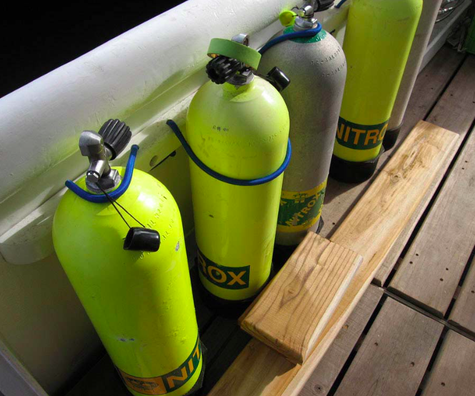Dive Operation on Cocos Liveaboard
The Dives
Our goal on the Cocos Dive Liveaboard is to introduce you to varied and exciting dives. Generally, we have two dives scheduled for the morning, 8 AM and 11 AM and another dive after lunch, around 2.30 PM. This schedule can vary depending on events, circumstances and opportunities that may present themselves. Our motto is never turn your back on a magnificent bait-ball, which can appear at almost anytime. Click here to view the different Dive Sites.
Once a thorough briefing from our dive-masters has been given onboard the mothership, our guests jump onto their respective skiffs and zip out to the chosen sites. Each support boat accommodates up to nine divers plus driver and dive-master, who always dives with the group.
After a short ride, each of the skiffs will reach a different dive site that is alternated on the following dive, allowing the two groups to dive the same areas but at different times of the day.
On the way to or from the planned dive sites it is very common for our skiff drivers to seek out the best spots for memorable surface experiences. To watch dolphins, mantas, whales, a promising bait-ball or just cruse up to some of the islands most beautiful attractions, which are only reachable by small skiff.
Dive Experience for Cocos Island
Cocos Island presents the same diving challenges as any other Pacific, Indian or Red Sea diving location. Cocos, however, is not recommended for inexperienced divers because it is an open ocean destination that requires advanced open water diving skills.
Please note, the minimum required level of certification to dive at Cocos is Open Water with the Specialty of Deep Diver. We also recommend having a minimum of 25 hours of diving experience.
Most dives are at depths deeper than 60 feet / 18 meters. At Cocos currents and visibility can be entirely different in just a few hours. Please note, the dive guide will always be the final authority as to whether a passenger can do any specific dive.
Safety
Safety is a Priority
Due to the remoteness of both Cocos and Malpelo, safety is an absolute priority at all times. This we have always understood and no dive operation takes it more seriously or is more prepared for all eventualities. Your safety is our first priority. Our Captains all have naval, military backgrounds. They are fully qualified and hold internationally recognized seafaring licenses. Many of our crew are Medic First Aid Instructors or are trained for basic first aid and as DAN O2 providers.
All of the boats' crews maintain peak performance skills for all conceivable emergencies including Man Overboard, Lost Diver Searches, Fire at Sea and more. It is the company policy that all of the ship's personnel performs these exercise drills on EVERY trip, while our guests relax.
Dive Briefing
We conduct a short dive briefing with white-board diagrams before each dive. Here the dive master will explain the site's dive strategy and highlight the points of interest of that particular dive. All dives are lead by the same dive master who did your briefing. The buddy-system is obligatory. A 60-minute maximum dive time is enforced.
Diving Practices
Since the nearest hyperbaric facility in San Jose is 36 hours away, it is imperative that we maintain safe diving practices within the recreational diving limits. Thus, decompression dives are fare not permitted and a maximum depth of 115 feet or 35 meters is imposed. To increase safety and bottom time while maintaining safe non-decompression dives, the use of Nitrox becomes essential. DAN O2 Emergency kits are present on all of our skiffs as well as on the mothership.
Cocos Island Emergency Evacuation Plan
We strongly recommend that our passengers have valid Divers Alert Network insurance or comparable insurance to provide coverage in the event of an accident. Cocos Island is a very remote area and the cost involved in evacuating a diver is very high. The D.A.N. policy is a vital protection to have. Please do not hesitate to contact us if you need assistance with obtaining dive insurance. Even if you do not have DAN, then you must have a dive specific insurance that covers evacuation specifically from Cocos Island.
A short-term cancellation insurance policy should be obtained in case of unexpected changes in your plans. Accident, medical and baggage insurance are also recommended.
Safety Kit & Nautilus Lifeline GPS
We provide all guests with our Safety Kit that includes an extra-large orange dive sausage, a powerful storm whistle and a special safety light.
We also provide the Nautilus Lifeline to all passengers, the units are tethered to each diver's BCD. When activated, the alarm is triggered aboard our vessel and the specific coordinates of the diver's location are communicated. The Lifeline automatically communicates not just with our own vessels, but with every modern marine VHF radio within a 12-mile range.
These units also transmit the Marine International Distress Signal that is monitored by all ships and coast guard vessels. This is a revolutionary diver locator device: it has taken existing technology (VHF radio GPS) and custom-designed it specifically for scuba divers.
Going Ashore

While at Cocos, several excursions on the island can be planned to complement your dive trips. Most popular is the visit to the isolated Ranger Station at Chatham Bay where pirates, whalers and visitors of yesteryear have carved graffiti on the large beach rocks.
Other excellent options are walks to one of the beautiful waterfalls where, after a short hike through the steamy tropical jungle, you can take a refreshing dip in one of several freshwater pools. Also available, depending on weather, are walking tours of the trail linking Chatham Bay to Wafer Bay. This hike offers marvelous panoramas of Cocos' remarkable shoreline and a rare glimpse of the island's daunting interior geography. It's a nature lovers' dream with spectacular, ancient tree ferns and bromeliads fighting for space on the huge moss-covered limbs of ironwood trees. The Cocos finch is almost friendly with little fear of man and the wild pigs, transplanted here during pirate days, can often be seen foraging in the clearings.

For the serious hikers among us and weather permitting, an eight-hour trek to the summit of Cerro Yglesias, the highest peak on Cocos Island, can be arranged. A visit to the main park ranger installation at Wafer Bay and its adjacent stream and forest can also be enjoyed when sea conditions permit a safe beach landing. Please note that all trips to and activities on Cocos Island must be pre-arranged and confirmed with the National Park Authorities. Permission, usually for the following day, can be efficiently acquired by our captain through direct ship-to-shore radio communication with the rangers.
Nitrox
Why Dive Nitrox?

Imagine that you are at Cocos Island diving one of the truly exotic locations on the planet. You strap on your wrist computer and plan the best air dive possible. But after too short a time on the bottom you are already hearing from your computer that it's time to begin to surface. Looking down while ascending, you see some others who began the dive with you but are still down there. They are wearing scuba tanks with a special green and yellow label: NITROX.
What is Nitrox? It's enriched air with a higher percentage of oxygen and a lower percentage of nitrogen than normal atmosphere. By reducing the amount of nitrogen in breathing gas, there is less to dissolve in our bloodstream for an equal time at a given depth. This translates into more bottom time with an additional benefit: a significant reduction of the effects of nitrogen narcosis.
Depending on the mixture, Nitrox can allow you as much as 50% more bottom time than the same dive with air.
Other advantages are shorter surface intervals due to less outgassing required and, at the end of a busy diving day, you'll actually feel less fatigued due to the reduced physiological effort required to outgas. Another bonus that many Nitrox divers report is generally reduced air consumption, further adding to bottom time.
Nitrox diving is simple, beneficial, and most importantly, safer than diving on regular air. This is especially true in places like Cocos Island, where the diving profile is moderately deep and where, due to the excitement of the experience, divers have a tendency to stretch the limits of diving on air.
In order to maximize your enjoyment and optimize your depth for each particular dive-site, the actual dive profile selection chosen by our dive masters is based on the Nitrox mixture used.
Nitrox Courses
If you are a certified Nitrox diver, then please remember to bring your Nitrox certification card with you! You will be asked to present proof of certification once onboard the vessel.
If you are not yet a certified Nitrox diver, it is necessary to obtain such training and certification prior to actually diving with us. The Undersea Hunter Group nitrox course and certification is available through TDI "Technical Diving International" before your arrival.
As a convenient alternative, we can certify you onboard at an additional cost. There are no special skills or in-water training associated with the certification. So you can simply plan on completing the three-hour theory course during the 36-hour cruise to Cocos or Malpelo Island.
Neither is there any alteration required as far as your equipment is concerned. It's only the gas mixture that is modified.
Practically speaking, Nitrox diving is as easy as breathing continuously, knowing how to work a dive table, analyzing your cylinder's oxygen content and not diving beyond the limits.
Nitrox fills are free and unlimited aboard our boats



















